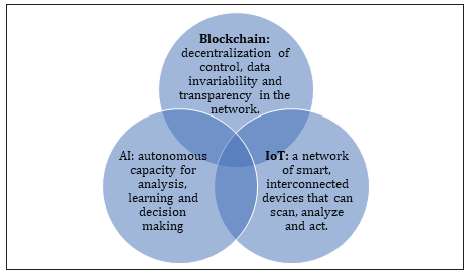- Submissions

Full Text
Research & Development in Material Science
Convergence Blockchain, AI en IoT
Jan Veuger*
Schools of Finance & Accounting, Creative Technology and School of Governance, Netherlands
*Corresponding author: Jan Veuger, Professor Blockchain Saxion University of Applied Sciences Enschede The Netherlands, Schools of Finance & Accounting, Creative Technology and School of Governance, Law and Urban Development, Netherlands
Submission: October 04, 2019;Published: October 15, 2019

ISSN: 2576-8840 Volume12 Issue1
Opinion
The inevitable convergence of the blockchain, AI and IoT will form an impactful combination of security, interconnectivity and autonomy to bring about a revolution in the way processes run. A combination of Blockchain, AI and IERT technologies that affect the potential of how businesses, industries and even economies function will redefine them more than they do today. Some applications and concepts have already seen an overlap between these technologies with promising results1. An example of this is the combination of AI and Blockchain to manage Unmanned Aerial/Air/Airborne Vehicle (UAV) air traffic, making mass autonomous flying safer. This application alone will redefine the business of aviation and logistics (Figure 1).
Figure 1:The individuals and disruption between blockchain, AI and IoT.

Blockchain enables a large number of computers to perform their tasks together and to store information in a decentralized, unchanging and universally accessible way.
IoT provides seamless interconnectivity between different everyday objects, equipped with sensors, microprocessors and transducers to create a network that can independently perceive and collect data, analyse it continuously and perform programmed tasks.
AI gives full autonomy in analyzing data, making decisions and taking action on computers or other smart devices. AI can be replicated under certain circumstances and even exceed human computational and cognitive capabilities. Organizations use AI to automate primarily repetitive, routine processes that may require large amounts of data processing and fast decision making based on pure logic.
The sum: the convergence of the block chain, AI and IOT
The convergence of Blockchain, A1 and IoT can enable organizations to maximize the benefits of each of these technologies while minimizing the risks and constraints associated with them. Since IoT networks cover a large number of connected devices, there are numerous vulnerabilities in the network, making it vulnerable to hacker attacks, fraud and theft. To prevent security problems, AI powered by machine learning can proactively defend itself against malware and hacker attacks. Network and data security can be further enhanced through a blockchain that can minimize illegal access to and modification of the data on the network. AI can also improve the functional capacity of the IoT network by making it autonomous and smarter.
A proven convergence of blockchain, AI and IoT is for example Fujitsu’s2 algorithm3 to measure employee heat stress levels. The algorithm continuously monitors workers’ physiological data (temperature, humidity, activity levels, pulse, etc.) using portable In- Vitro Diagnostic Devices (IDA) and sensors to track the correlation between different factors with workers’ health. The analysis can help the organization to improve working conditions and prevent workers’ health problems. Applying Blockchain to this system can help to keep track of more personalized data by ensuring privacy or can help to pay out health insurance amounts using smart contracts.
The expected impact of the convergence of Blockchain, AI4 and IoT is (yet) incalculable and its existing applications are not (yet) perfect. Many organizations, especially the early adopters, are highly enthusiastic about the value of cognitive technologies and are therefore investing in them. Findings from applications are (still) at an early stage and are not yet as advanced as is necessary to achieve real transformation. The same can be said of the IoT and Blockchain. With increased interest, investment and innovation, the convergence of the block chain, AI and IoT will become a reality.
Foot note
1 https://www.odyssey.org/
2 https://www.computable.nl/artikel/nieuws/security/6765432/250449/fujitsu-komt-met-nieuwe handpalmidentificatie.html
3 https://www.fujitsu.com/cn/en/about/resources/news/press-releases/2019/frdc-0222.html
4 https://www.tno.nl/nl/tno-insights/artikelen/artificial-intelligence-angst-verlangen-en-toepassing/.
© 2019 Jan Veuger. This is an open access article distributed under the terms of the Creative Commons Attribution License , which permits unrestricted use, distribution, and build upon your work non-commercially.
 a Creative Commons Attribution 4.0 International License. Based on a work at www.crimsonpublishers.com.
Best viewed in
a Creative Commons Attribution 4.0 International License. Based on a work at www.crimsonpublishers.com.
Best viewed in 







.jpg)






























 Editorial Board Registrations
Editorial Board Registrations Submit your Article
Submit your Article Refer a Friend
Refer a Friend Advertise With Us
Advertise With Us
.jpg)






.jpg)














.bmp)
.jpg)
.png)
.jpg)










.jpg)






.png)

.png)



.png)






